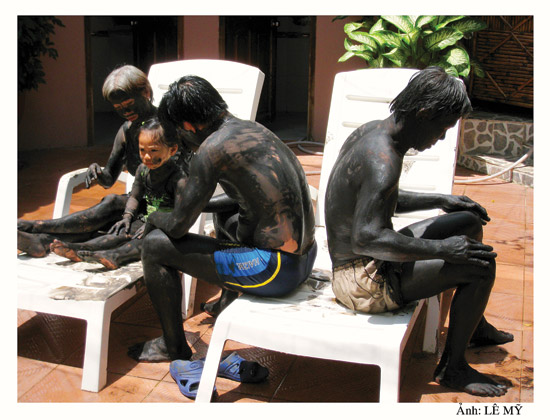(No.1, Vol.3, Jan-Feb 2013 Vietnam Heritage Magazine)

Visitors at the mud bath area .
Photo: Le Thang My
150km southeast of Ho Chi Minh City and 70km northeast of Vung Tau City, Binh Chau – Phuoc Buu Nature Reserve features flat terrain with rivers, springs, lakes and seas.
At present, there are 40 tourism enterprises, both international and domestic ones, investing in the central and the surrounding areas of Binh Chau – Phuoc Buu forest. One of these is the Binh Chau Mineral Hot Spring Ecotourism Resort in Binh Chau commune.

A hot water well in which
visitors boil eggs in bamboo baskets.
Photo: Dang Khoa
The bilingual Vietnamese – English leaflet of this resort says that in 1928, on a field trip to research Vietnamese forests, a French doctor discovered a hot-watered spring in the middle of the jungle and named it after the name of the nearby village of Chau Ro ethnic, Cu My. By 1984, western scientists evaluated that Cu My hot-watered springs had many components and physicochemical properties similar to other famous hot-watered springs in the world. Since then, Binh Chau Mineral Hot Spring Ecotourism Resort was established and is now ranked 4-star, with an area of 33 ha.
I bought an entrance ticket at VND30,000 per adult. As soon as I entered the gate, I saw hotels, bungalows, restaurants, bars, souvenir stalls, tennis-courts, golf courses, swimming pools, camping areas, recreation areas for children. Most of these are under the cool shade of the forest trees. Small paths paved with flagstones or bricks wind through one site to another.
The resort has 70 sites, each spraying hot water ranging from 45oC to 82oC.
Among the many activities such as crocodile fishing, tennis and visiting the primitive forest by horse-cart, those related to hot-watered springs such as foot bath, hot-watered bath and mineral hot mud bath attract most visitors.

Inside the resort
Photo: Dang Khoa
With a ticket for foot bath at VND40,000 per adult, my friend and I entered a shady section about 1,500 square meters with about 30 small pools, which looked like bathtubs containing knee-level water. Each pool had some visitors soaking their feet and chatting about the medical benefits of mineral hot water.
As soon as I dipped my feet into the water, I rushed to pull them up. The man sitting next to me said: ‘You feel too hot at first, but after several minutes you will enjoy it.’ Just as the man said, after 15 minutes, I felt my feet soothed.
Next to the foot bath area are nine wells, 1.5 meters in depth, in which the water is moving as if being boiled. Visitors can buy eggs from the shop nearby and put them into bamboo baskets to drop down into the 82oC water, and then wait for 15 minutes to serve.
A local man said: ‘20 years ago, whenever I caught any animals from the forest, I would bring them here, butcher and soaked them into its hottest pool, and then I picked them up after 20 minutes to eat them with rice wine. The meat was so delicious.’
At the section for ‘mineral hot water bath’, I bought a ticket for VND150,000 and when I went inside, I saw two pools about 100 square meters in size. As soon as I jumped into the water, I was startled to feel like I was being abruptly plunged into boiling water. However, after 30 seconds, I felt so relaxed and cozy that I spent an hour more to soak.
Nearby are many huts for mineral mud bath at the price of VND400,000/ person. A staff member took me to a 3m-by-3m hut with two bathtubs placed under the ground, and then he tore open the mud bag and told me how to bathe.
Following the instructions, I flushed the 37oC mineral hot water to fill in the bathtub and soaked myself from top to toe for about 15 minutes, dried myself and rubbed smooth pasty black mud all over me. Though the information on the bag said ‘37oC mineral hot mud’, I just sensed slight warmth on my skin. After 20 minutes blurred with the dark sludge, I took a bath again with warm water and felt completely relieved.

Visitors soak thier feet at the foot bath area.
Photo: Dang Khoa
In the afternoon, I went to the restaurant inside the resort and ate a plate of rice with stir-fried squid and fish for a reasonable price. The restaurant had hundreds of dishes such as chicken, pork, beef, ostrich, seafood, brackish water and fresh water products. All of these dishes were listed in English and Vietnamese.
From Ba Ria Town centre, follow the National Highway No. 55 about 50 km to the northeast, and you will reach Binh Chau fork at the milestone 46km and 800m, where you turn left and go about three km; there you find Binh Chau mineral hot water spring ecotourism resort.
The prices of the rooms at the resort are from VND800,000 to VND6,000,000/night. There are tens of hotels and guesthouses with rooms for two persons at VND100,000/night/ room with a fan or from VND150,000 to VND200,000/night/room at Binh Chau commune centre, five km away from the resort.
This section, covering Baria-Vung Tau Province, is sponsored by Baria-Vung Tau Department of Culture, Sports and Tourism.

